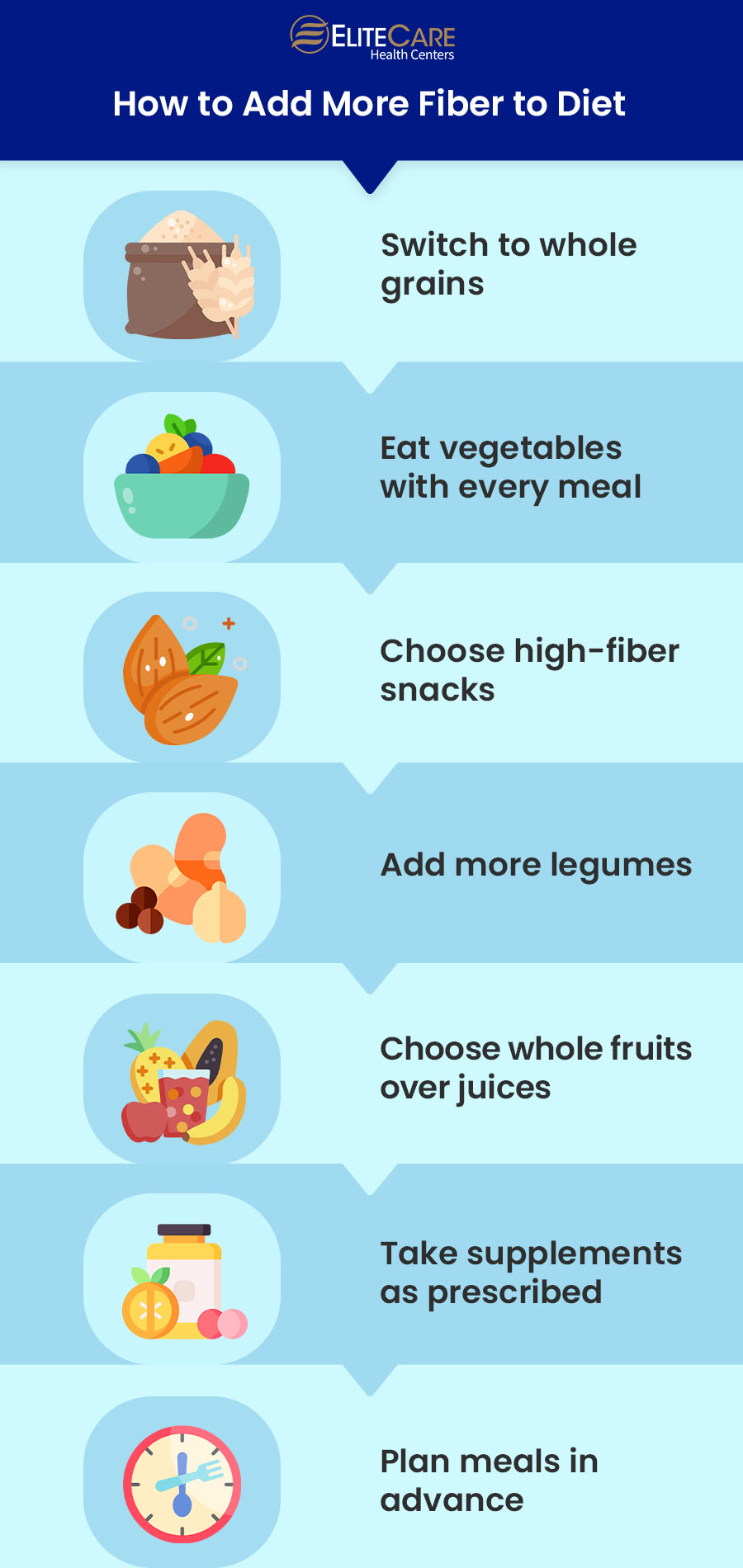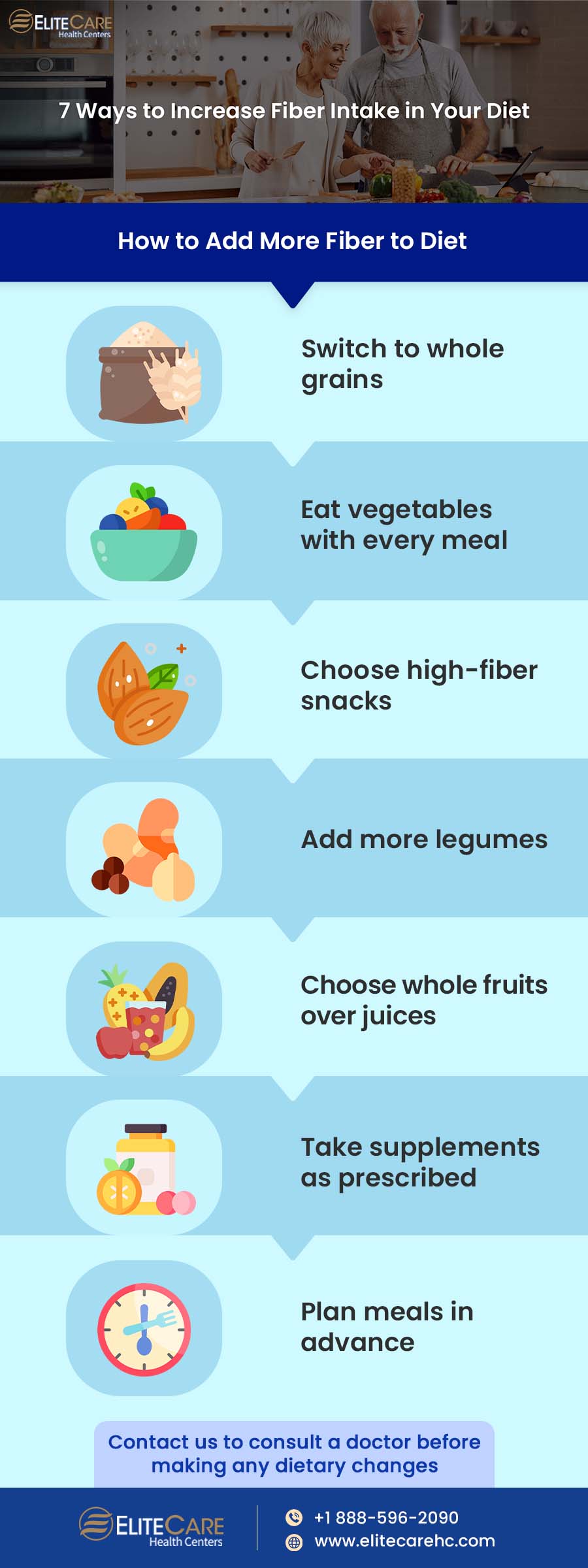
Fiber, also known as dietary fiber or roughage, is a type of carbohydrate that our bodies cannot digest. Soluble fiber absorbs water and forms a gel-like substance in the gut, which helps slow down the digestion process and reduces blood sugar levels. On the other hand, insoluble fiber does not dissolve in water or gastrointestinal fluids. But it stays intact and moves through the digestive tract to keep the digestive system healthy by adding bulk.
In this blog post, we will share the importance of fiber in diet, the recommended daily intake of fiber, and how individuals can increase fiber in the diet. Read on to learn more.
Why Is Fiber Important for Seniors?
Promotes regular bowel movements
As we age, constipation can become more common due to changes in the digestive system. Fiber can help promote regular bowel movements by adding bulk to the stool and softening it, making it easier to pass. When we increase fiber in diet, it absorbs water in the digestive tract, increasing the size and weight of the stool. It stimulates the muscles in the digestive tract to push the stool forward, promoting regular bowel movements.
Lowers blood glucose levels
Fiber can help regulate blood sugar levels by slowing down the glucose absorption rate in the bloodstream. Soluble fiber, in particular, can help regulate blood sugar levels by slowing down the absorption of carbohydrates and reducing the postprandial glucose response (the increase in blood glucose levels after a meal).
Maintains heart health
Soluble fiber can help lower cholesterol levels by binding to cholesterol in the digestive tract and preventing it from being absorbed into the bloodstream. High levels of LDL (bad) cholesterol are a major risk factor for heart disease, so reducing cholesterol levels can help promote heart health.
Besides, fiber can also help reduce inflammation in the body, which is one of the key contributing factors behind heart disease.
Supports weight management
Fiber is bulky and takes up space in the stomach, which can help you feel full and satisfied after eating. As a result, it can reduce the likelihood of overeating or snacking between meals, therefore, aiding in weight management.
In addition, fiber helps regulate blood sugar levels and prevent spikes and crashes in energy. It can help reduce cravings for sugary or high-fat foods, which can contribute to weight gain. Moreover, soluble fiber can bind to fat in the digestive tract and prevent it from being absorbed into the bloodstream. It can reduce the number of calories absorbed from the diet and support weight loss efforts.
How Much Fiber Do Seniors Need?
How to Add More Fiber to Diet

1. Switch to whole grains
Replace refined grains with whole grains to increase your dietary fiber intake in your diet. While whole grains contain the entire grain kernel, refined grains are milled, where the bran and germ present.
Instead of white bread or white rice, choose whole wheat bread, brown rice and quinoa.
2. Eat vegetables with every meal
Eating your vegetables at the beginning of every meal is a good strategy to get adequate fiber. Have more non-starchy vegetables as they are particularly low in calories and high in nutrients, including fiber.
Vegetables such as broccoli, Brussels sprouts, artichokes, peas, spinach, sweet potatoes, squash, and green beans are all high in fiber. Other vegetables such as kale, okra, and turnips are also good sources of fiber. A daily intake of four to five servings of vegetables is recommended to meet your daily fiber needs.
3. Choose high-fiber snacks
Replace the unhealthy processed and fried snacks with fresh fruits, raw vegetables, low-fat popcorn, and whole-grain crackers. Nuts or dry fruits are also good sources of fiber. However, be careful about adding these to seniors’ diet plans since they are high in calories.
4. Add more legumes
Legumes are rich in insoluble fiber, which is the kind of fiber that helps move food through the digestive tract and can help prevent constipation. Legumes that are particularly rich in fiber include chickpeas, split peas, black beans, kidney beans, soybeans, etc.
5. Choose whole fruits over juices and smoothies
Whole fruits provide more fiber than fruit juice because when the fruit is juiced, the fiber-rich pulp is removed. Eating whole fruits gives you the benefit of consuming fiber-rich pulp, skin, and seeds. Some of the common fiber-rich fruits include avocados, raspberries, blackberries, apples, pears, oranges, bananas, etc.
6. Take supplements as prescribed
Supplements are used to fill in nutrient gaps in diets. Fiber supplements come in a variety of forms, including powders, capsules, and bars. These supplements are easier to digest than fruit juices or certain legumes. It is crucial to contact a healthcare center and talk to a primary care physician before taking any supplements.
7. Plan meals in advance
When individuals plan their meals in advance, they have the time to look for recipes that are rich in fiber, such as whole grains, legumes, vegetables, and fruits. Additionally, it will also be possible to have all the ingredients on hand for fiber-rich meals. This can help in saving time and effort in the kitchen, while still ensuring that seniors are getting enough fiber in their diet. For example, some recipes that can provide more fiber include:
- Veggie soups and stews
- Whole-grain bread and muffins
- Lentil-based curries
- Quinoa salads
- Oatmeal with fresh fruit
Individuals should not make any drastic changes to their diet without consulting a primary care physician as well as a certified dietitian. Contact a healthcare center that provides primary services for seniors and schedule an appointment for detailed dietary advice.
Conclusion
Although fiber is crucial to maintain overall health and well-being, seniors need to be careful about eating a lot of fiber at one go. Excessive fiber in diet can cause bloating, diarrhea, and abdominal cramps. Seniors can avoid such issues by gradually increasing their fiber intake every day. Also, it is crucial to drink plenty of fluids each day—about 16 ounces of water, four times a day to help the fiber pass through the digestive system easily.
Always consult a primary care physician and a certified dietitian before making any significant changes to your diet plan. Contact EliteCare Health Center, one of the medical clinics in Florida that offers a wide range of primary services. Schedule an appointment and visit your nearest center to consult our board-certified primary care physicians.






